WW1 British Submarines
 United Kingdom (1890-1918) About 350 subs 1885-1921.
United Kingdom (1890-1918) About 350 subs 1885-1921.
WW1 British Submersibles:
Nordenfelt Class | Holland Class | A class | B class | C class | D class | E class | F class | G class | G class | H class | J class | K class | HMS Swordfish | HMS Nautilus | L Class | M class | R class | S classV class | W classOverview of British ww1 submarines
In the general sense, the very conservative Royal Navy always considered surface warfare like the only “honorable way” to do battle on the seven seas. Submarines were either not considered as to be trusted (not proven) in the 1890s, and good only for small navies and defensive purposes only. For a truly naval superpower, it just had no reason to be developed. The same reasoning made torpedo-boats long lasting at the fringe of the British “naval dust”. Only destroyers (at that time still considered as TBDs or “torpedo boat destroyers” have some right to exist alongside cruisers and battleships, thanks to their range and high seas capabilities. 80 submarines were in service when the Great War broke out in 1914.

HMS Holland 1, first British submarine, in trials 1902
This mistrust however ended when Admiral John Arbuthnot “Jacky” Fisher arrived at the head of the admiralty in 1914 (first sea lord). This energetic figure, innovator, strategist and developer of the navy introduced both torpedo boat destroyers and fast monocaliber battleships of the Dreadnought class, created the Battlecruiser concept, encouraged the introduction of submarines into the Royal Navy, and the conversion to oil-fuelled only ships at large.

C-class submarines (author’s vector illustration)
![]()
C class, experimental vector-photoshopped illustration
Introduction – The first British subs
When decision was made to test a small serie, rather than rival France, UK turned more naturally towards USA and the most important manufacturer then that was John Holland. Licence was acquired and the boats were built at Vickers, Barrow-in-Furness and simply denominated as the “Holland” serie. Holland 1 was launched 2 October 1901 and decommissioned 5 November 1913. In fact the five built only saw training in home waters. Hollands’s designs were famous to be fast and deep diving, with excellent agility underwater due to their electrical propulsion, but suffered of being relatively complicated and having poor range and surface speed.
Holland class specifications |
|
| Dimensions | 19.5 x3.6 x3.0m |
| Displacement | 113/122 t FL |
| Crew | 8 |
| Propulsion | 1 screw, 1 4-cyl Wolseley engine, 1 electric mot. 160/70 hp |
| Speed | 7.5/6 knots ( kph; mph) surf/sub |
| Range | 500 nmi ( km; mi) at 7 knots ( km/h; mph) |
| Armament | 1x 457mm TT, 3 torpedoes |
Prewar subs: A, B and C classes
A class (1902)
13 boats derived from the Holland model, but way more larger were built at Vickers, Barrow-in-Furness, this time only using part of the former licence. There were considerable variation amongst the boats, as the serie was revised on the fly until 1905. Various propulsion were tested, battery-powered electric motors and shaft-drive Wolseley petrol engines, 400 bhp (300 kW) (A1) for surface warfare, 450 bhp (340 kW) (A2,A3,A4), 600 bhp (450 kW) (A5 to A12). The last, A13 tried an experimental 500 bhp (370 kW) heavy oil diesel engine by Vickers, which proved unreliable. Range was however increased as well as surface speed. The first was 31.5 x3.6 x3.1 m large. All were given the same Wolsleley 16-cylinder engine, but power output ranged from 350 to 450 hp, even 600 hp for the last serie A8 to A12. Armament also varied, the A5 to A13 having two instead of a single TT.
A class specifications |
|
| Dimensions | 32 x3.9 x2.3m |
| Displacement | 190/207 t FL |
| Crew | 11 |
| Propulsion | 1 screw, 1 16-cyl Wolseley engine, 1 electric mot. 350/125 hp |
| Speed | 9.5/6 knots ( kph; mph) surf/sub |
| Range | 320 nmi ( km; mi) at 10 knots ( km/h; mph) |
| Armament | 1/2x 457mm TT, 3/4 torpedoes |
B class (1904)
More homogeneous, these 11 boats were similar to the previous class, still ordered for coastal patrol work and relying on petrol engine (surface propulsion) and batteries (underwater propulsion). Armament was limited to two forward tubes in the prow, with four torpedo spares. Top speed (surface was 12 knots (22 km/h; 14 mph)) but range was increased to 1000 nautical miles. The main improvements were a substantial deck casing to improved submerged performances and and a bigger reserve of buoyancy. They were also fitted with a pair of hydroplanes as the forward end of the conning tower to improve underwater handling. This feature was not repeated in following classes, but reintroduced on US submarines half a century later for the very same reason… In action: The first six (out of 11 boats) were sent to the Mediterranean, but mothballed from the autumn of 1915 because of the lack of spares. An arrangement made them rebuilt by the Italians as patrol boats in 1917, with their electric engines removed, a forecastle raised, a new superstructure added, and a platform for the 12 in gun.
B class specifications |
|
| Dimensions | 19.5 x3.6 x3.0m |
| Displacement | 113/122 t FL |
| Crew | 8 |
| Propulsion | 1 screw, 1 4-cyl Wolseley engine, 1 electric mot. 160/70 hp |
| Speed | 7.5/6 knots ( kph; mph) surf/sub |
| Range | 500 nmi ( km; mi) at 7 knots ( km/h; mph) |
| Armament | 1x 457mm TT, 3 torpedoes |
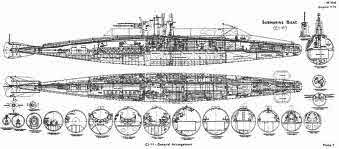
C-Class blueprints
C class (1906)
Having built three classes of submarines, the Admiralty felt confident enough to embark on a large serie. Some 38 boats of this class were built, having the distinction to be the last Royal Navy development of the Holland-Type, using petrol engines for surface. This was essentially a large coastal design however, and in that delayed the construction of proper sea going boats. The decision falls squarely on Fisher, that advocated submarines for harbour and coastal defence only and even saw them as substitutes for minefields. Despite their limitations like petrol engines, limited armament and cramped interiors, the Type C saw active service throughout the war. The last was launched in 1910. Six were built at Chatham Dyd, partly to ensure the yard keep up with submarine design development. In general appearance they were stille very much like the B, only for the diving planes amidships. An interesting note for modellers, many were camouflaged towards the end of the war.
Action service includes the Zeebruge raid, when the elderly C1 was converted to destroy the viaduct during the famous 1918 raid. Eventually kept as a backup, this task fell on the C3, loaded with explosives and conducted on 23 april 1918 to the Belgian base, later succesfully blew up to severe the link of the mole to the shore and prevent reinforcements. The C11 was sunk in collision with steamer SS Eddystone off Cromer. The C14, C17 suffered the same fate (first with TB N°27, second with HMS Lurcher), but both were salvaged and repaired. The C26, 27 and 35 served in the Baltic from 1916, they were scuttled on 4 April 1918 off Helsingsfors to avoid surrender to the Germans. The C32, also served in the Baltic but was stranded and scuttled in the gulf of Riga.
C class specifications |
|
| Dimensions | 43.3 x3.1 x3.5m |
| Displacement | 287/290 t FL |
| Crew | 16 |
| Propulsion | 1 screw, 1 16-cyl Vickers engine, 1 electric mot. 600/300 hp |
| Speed | 13/7 knots ( kph; mph) surf/sub |
| Range | 1,000 nmi ( km; mi) at 8.5 knots ( km/h; mph) |
| Armament | 2x 457mm bow TT, 3 torpedoes |
D class (1908)
At last, these were the first type of oceanic and overseas patrol capabilities approved by the Admiralty. These eight British submarines were much larger than previous types, with almost twice their displacement, diesel engines, more than 2,5 times the range, one more TT tube, two more torpedoes and a gun (at least for one). Out of range, diesels also stopped the dangerous petrol emanations that caused so many accidental explosions in previous boat. Another great novelty in design was the adoption of saddle tanks and the two screw propellers gave some extra agility. The D types also received radio sets, with emitter units, not the case for previous classes, through an extendable telescopic mast. Contemporary references showed the entire class equipped with as many as two guns in some cases, but in fact only the C4 tried one, a 12 pdr (76mm) installed on a platform. At last also the D types possessed proper conning towers, allowing several officers to scan the horizon. In action, the D2 was sunk by German patrol boats while attempting to cross the Ems estuary, and the D3 was sunk by error by a French airship, while the D6 was torpedoed by the UB 73 off Northern Ireland.
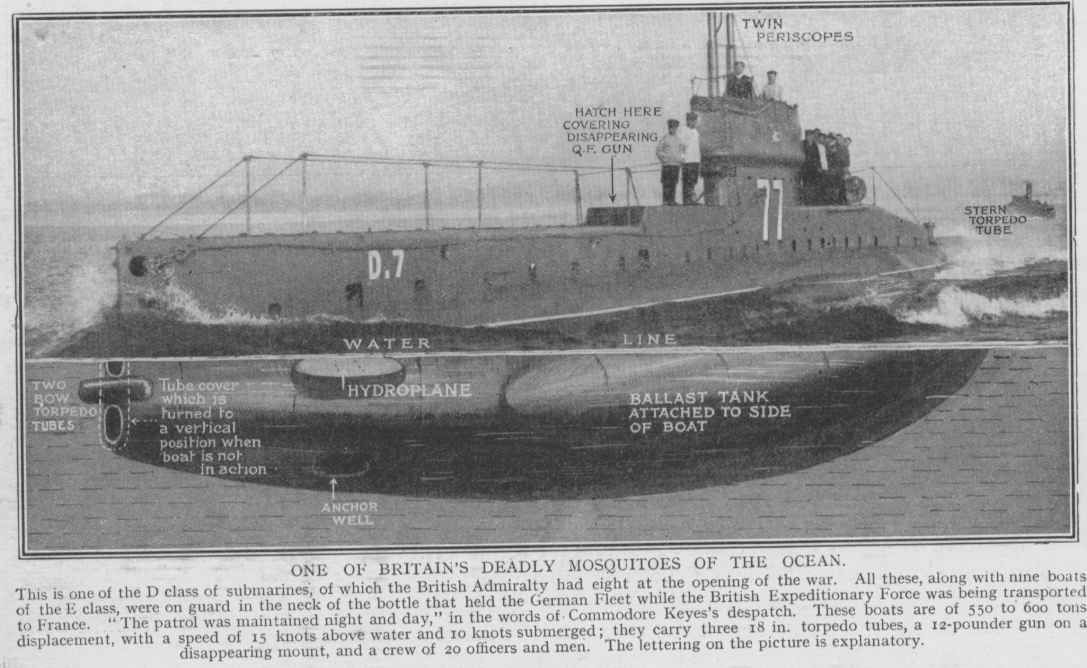
D-class submarines
D class specifications |
|
| Dimensions | 49.7 x6.2 x3.2m |
| Displacement | 483/595-603-620 t FL |
| Crew | 15 |
| Propulsion | 2 screws, 2x 6-cyl Vickers Diesels, 2electric mot. 1200/550 hp |
| Speed | 14/9 knots ( kph; mph) surf/sub |
| Range | 2500 nmi ( km; mi) at 10 knots ( km/h; mph) |
| Armament | 2x 457mm TT (2 bow, 1 stern), 6 torpedoes |
Wartime British Submarines
About 156 Submersibles (approximately) in all:
The first submersibles of the war series were the “E”, in fact the continuation of a class begun in 1913, which will comprise 47 units in total, operational between 1914 and 1916. Inspired by the Italian submarines designed by Laurenti, the 3 “S” of 1915, the 4 “V” followed in 1915, the 4 “W” in 1915-16, the 3 “F” in 1915-17, the HMS Nautilus (1915) and HMS Swordfish (1916). All were prototypes, but operational during the war but the K26. Larger series were the 14 “G” in 1915-16, 17 oceanic “K” in 1916-17 and seven “J” in 1915-17, twenty “H” in 1917-19, 34 “H bis” in 1917-19 (Of which more than 50% did not see service during the Great War, being released too late.
The 12 “R” of 1918 however did saw action, as well as the eight of the “L” type in 1917, 19 “L-bis”, half of which entered service just before the armistice. 5 ships of the L50 class only were completed post-war, all the remaining ordered leading to mass cancellation. The most gigantic British submersible of WW1, has been, without contest, the three of the class “M”, classed as submersible cruisers and equipped with a 305 mm gun intended for coastal bombardments on Belgian shores. Only the M1 became operational before the armistice but they remains the most powerfully gunned subs of all times.
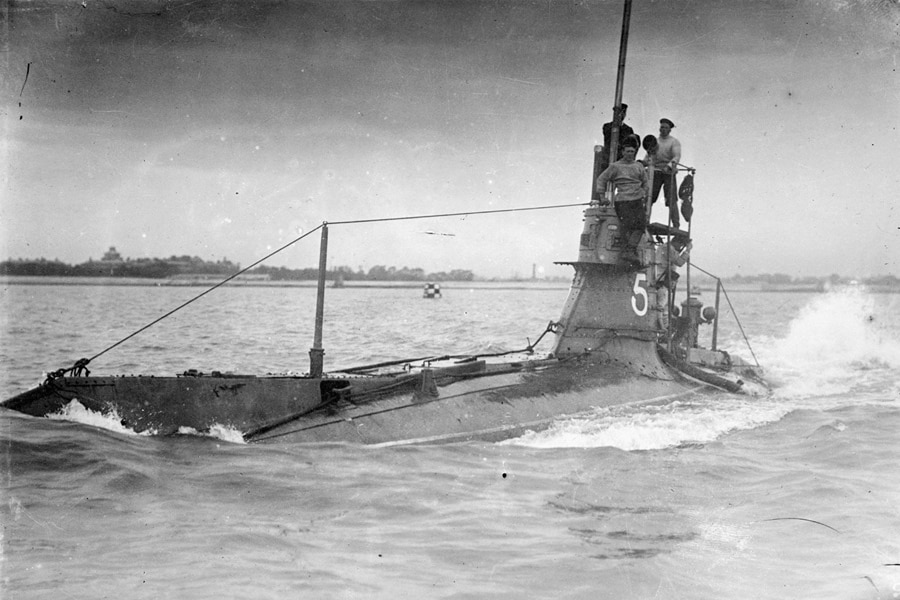
A5 of the A-class submarines, cdts. theatlantic.com
E class (1914), sub workhorses
These 60 submarines were distributed in two groups. E1 group comprised 8 boats, plus two AE in service with the RAN (Royal Australian Navy), all built either by Chatham or Vickers. These were among the first of the 1911-12 programme of six enlarged and improved D types. One of the change was the addition of beam TTs optimized for short-range shootings. As a result, these boats received only one tube at the bow and stern and two amidship. Standard for propulsion were the same Vickers 4-stroke diesels, although E3 tested Belgian 2-stroke Carel diesels.
One major innovation was the provision of two watertight bulkheads. With their long range these successful subs saw heavy action and lost 50% of their numbers, sunk by mine, torpedo, sunk or disappeared. E7 for example tried to force nets in the Dardanelles, trapped, the crew was made prisoner and the boat and was sunk by UB14. But she did several successful sorties in the Marmora sea. E8 was lost and scuttled in the Baltic in 1918, AE2 off Bismark archipelago.
The second group called E9 comprised 47 ships (three were never achieved). They were built at Chatham and Vickers but also later Palmer, John Brown, Fairfield, Denny, Beardmore, Thornycroft, White, Yarrow.. incorporating early lessons learned with the D and early E class subs. The Admiralty renounced to an improved D type and preferred to mass-produce the basic E1 type with some improvements. They were 3 feet longer to incorporate one more bow TT, the tubes reverted to a side-by-side TT configuration, the bulkhead moved aft for better loading. The engines were moved forward, the conning tower was enlarged and now included a steering position, and a third watertight bulkhead was added.
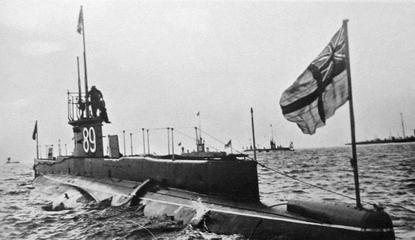
E9, seen from the stern.
The Chatham design was the norm, but a few boats were built to a slightly modified Vickers design, apparently with one bow TT for some time. On 11 November 1914 contracts were awarded to the various shipbuilder, on a Chatham licence. From E19, these boats were given a plough bow, and some were armed, following the experience in the sea of Marmora: E20 had a 6 inches howitzer, and E11-12 when at Malta were fitted with 12-pdr guns (76 mm). Some North sea boats also had 12 pdr guns. In 1916, E22 tested a launching ramp for a Sopwith Baby floatplane, used in Heligoland Bight. Other modifications included the addition of extra Torpedo external cases, and the external rudder was often eliminated.
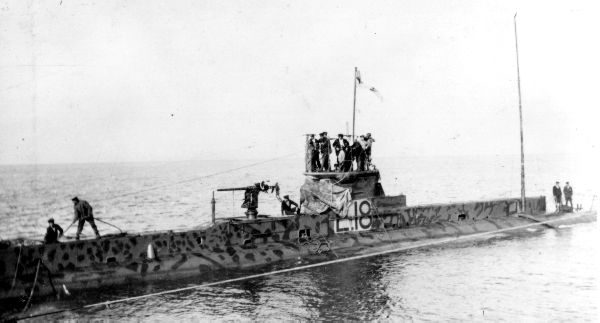
E18. Submarines of the E-type were often camouflaged. At least three patterns has been identified.
They had interesting career, most surviving the war. Three were scuttled in the Baltic to avoid capture, one was sunk in Marmora sea, one by a German decoy ship K, and E41 accidentally rammed by E4, both sinking with heavy losses.
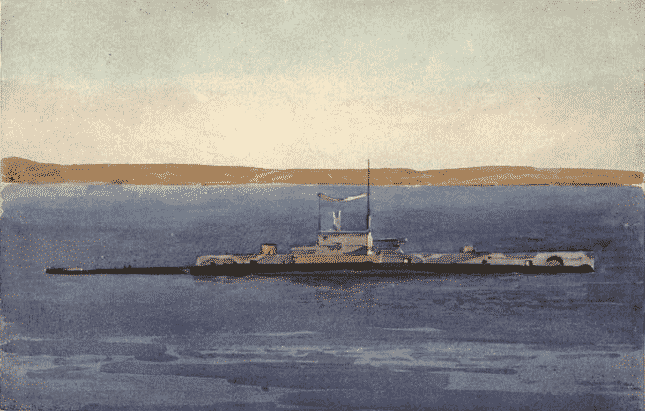
HMS E11 in the Dardanelles, painting.
E9 class specifications |
|
| Dimensions | 55.2 x 4.6 x 3,8 m |
| Displacement | 667 t, 807 FL |
| Crew | 30 |
| Propulsion | 2 screws, 2 Vickers 8-cyl diesels, 2 electric engines, 1600/840 hp |
| Speed | 15/9 knots () |
| Range | 3,000 nmi at 10 knots |
| Armament | 4-5 TT 457 mm, wartime 1x 12 pdr 18cwt (76 mm) |
S class (1914), the “Italian” ones
This little-known class was the result of a visit by the Admiralty to FIAT-San Giorgio La Spezia yard in Italy back in the summer of 1911. They were shown the Medusa and Velilla in construction. Back in UK, Scott shipyard, owner of FIAT’s Laurenti double hull licence since 1909, offered in September 1911 to built this type of submarine for fifty thousand pounds, a request that was accepted by the Admiralty, resulting in the S1. She was launched 28/2/1914 and featured a partial double-hull for a size comparable to the C class, excellent buoyancy and cruise due to a refined hull with a “ducktail” stern. Their compartimentation included no less than ten watertight bulkheads. However, diving time and top speed were inferior than the C class.
Eventually, only three were delivered by Scott, S2 (14 April 1915) and S3 (10 june 1915) following the S1. The class has been said to be unfit for northern sea conditions, but it’s difficult to assert. On 25 October 1915 all three were transferred to the Italian Navy. Their fate is obscure.
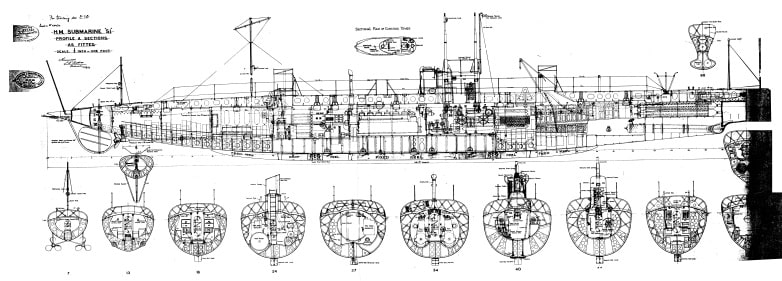
S class blueprint.
S class specifications |
|
| Dimensions | 45.1 x 4.4 x 3,2 m |
| Displacement | 265 t, 324 FL |
| Crew | 18 |
| Propulsion | 2 screws, 2 Scott-FIAT 6-cyl diesels, 2 electric engines, 650/400 hp |
| Speed | 13/8 knots () |
| Range | 1,600 nmi at 8 knots |
| Armament | 2 TT 457 mm (4 torpedo), 1x 12 pdr 18cwt (76 mm) |
V class (1914)
Basically these four, 386 tonnes submarines were launched in July 1914, March and November 1915. This new type was planned by the Submarine Committee back in 1912: A new overseas 1000t type and a coastal 300t type, the latter being derived into the S and F types. However Vickers privately planned its own version, and a short semi-experimental serie was accepted. They were close to the S type but with a partial double hull extending 75ft amidship, rather than the 45ft of the S class. However the battery capacity was rather low, with 132 exide cells versus 166, which weighted on their submerged endurance, but their designed speed was reached. The first used Laurence Scott electric motors and 300 hp engines, the three others Don Works motors. They also had two lots of 21 in frames in the torpedo and battery compartments. The foremost tank compartment was shortened. All four survived the war and were broken up in 1920-21.

V class specifications |
|
| Dimensions | 43.9/45 x 5 x 3,5 m |
| Displacement | 386 t, 453 FL |
| Crew | 20 |
| Propulsion | 2 shafts, Vickers diesels, 2 electric motors 900/450 hp |
| Speed | 14/8.5 knots () |
| Range | 3000 nmi at 9 knots |
| Armament | 2 TT 457 mm (4 torpedo), 1x 12 pdr 18Pdr (76 mm) |
W class (1915), the “French” ones
Four, 321 tonnes submarines, that has been inspired by the French Schneider-Laubeuf design, on which the admiralty was not too keen, preferring the FIAT-Laurenti one. Nevertheless, Armstrong Withworth was ordered two, just to keep the building pace. The first two were ordered in December 1913, and the two others seven month later, with many modifications by Laubeuf to meet the British requirements. The main difference between the two pairs was the absence of drop-collars for the second. Engines were Schneider-Laubeuf types, 8cyl. in the first pair and 6 cyl. in the second. The hull pressure diameter was rather small but there was no internal framing. Diving control was excellent, with practical and efficient installations, however agility was not and diesels were somewhat unreliable. These non-standard ships were soon handed over to the Italians in 1916. In that capability they received an additional 3 in/30 cal. gun. W4 was probably sunk by a mine, all three others were striken and BU after the war.
W class specifications |
|
| Dimensions | 15.7-52.4 x 4.7-5.4 x 2.7-2.8 m |
| Displacement | 331/321 t, 499/479 FL |
| Crew | 18 |
| Propulsion | 2 shafts, 8-cyl. diesels, 2 electric motors 710(760)/480 hp |
| Speed | 13/8.5 knots () |
| Range | 2500 nmi at 9 knots |
| Armament | 2 TT 457 mm (2 torpedo), 4 drop collars, or 4 bow, 3in (76 mm) AA |
F class (1915)
Three subs, 363t, built by Chatham, White and Thornycroft, prototypes of the admiralty 1912 coastal design. F2 has a MAN diesel (licence built by White), the two others Vickers ones. The battery comprised 128 Exide cells. Two additional ones were ordered in 1914 but later cancelled. These small submarines saw little service, since no coastal attack needed their deployment.
F class specifications |
|
| Dimensions | 46 x 4.9 x 3.2 m |
| Displacement | 363/525 t FL |
| Crew | 19 |
| Propulsion | 2 shafts, 2 diesels, 2 electric motors 900/400 hp |
| Speed | 14/8.75 knots |
| Range | 3000 nmi at 9.5 knots |
| Armament | 3 TT 457 mm (2 bow, 1 stern, 6 torpedoes), 1×2 pdr |
HMS Nautilus (1915)
A single, large oceanic type planned by the admiralty in 1912 which displaced 1441t. She was launched at Vickers 31 December 1914, which as predicted did not met the 20 knots requirement with their diesels. Eventually the 78.8 m long (258 ft) submarine was given a pair of shafts fed by two V12 diesels, and two electric motors which produced 3700 hp in surface and 1000 submerged, for a top speed of 17 knots and 10 submerged. She carried eight torpedo tubes (2 bow, 4 beam, 2 stern, 16 tropedoes in store), one 3in (76mm) gun. Completed in October 1917 she was never really given a chance and spent the rest of her career as a depot ship, before being broken up in 1921.
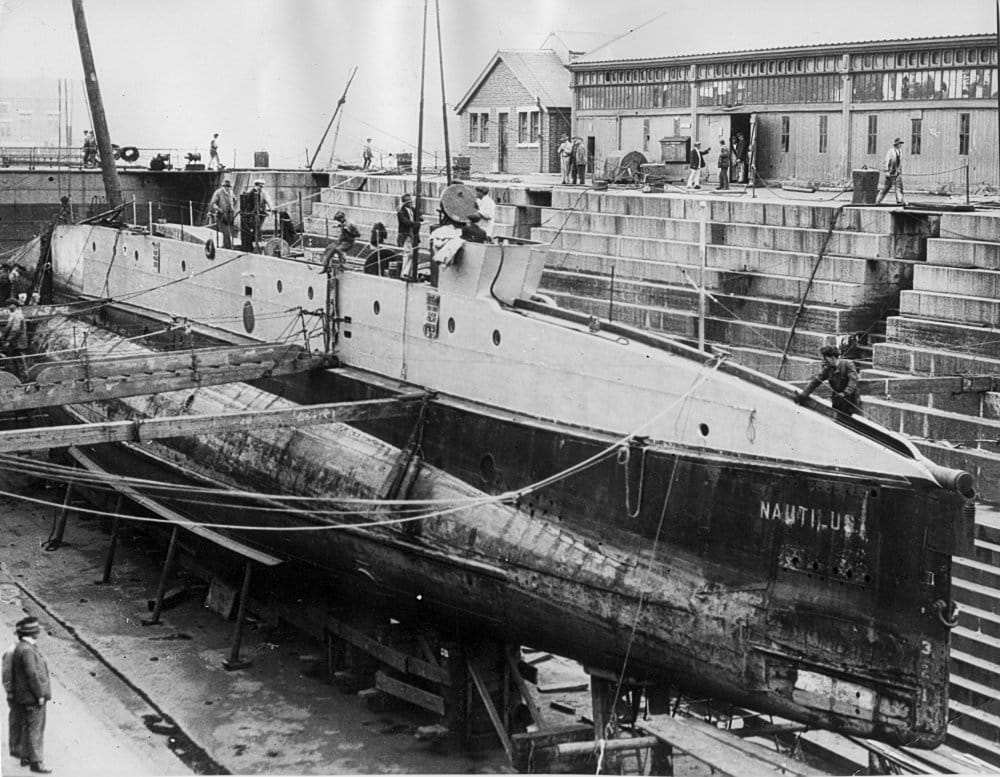
HMS nautilus in completion at Devonport in 1917
HMS Swordfish (1915)
This second, 932t oceanic design was proposed by Laurenti, the admiralty still hoping reaching its required 20 knots top speed. FIAT 14 bis design was locally developed by Scott, which augmented the displacement, reduced the autonomy and added a heavier displacement. She has a double hull for 75% of the lenght, but more crucially, rather than diesels, she was given two Parsons geared impulse-reaction steam turbines (fed by a single Yarrow boiler)), two electric motors for a total of 4000 hp when submerged and 1400 underwater. When cruising, a small funnel was lifted. Top speed was 18 knots and range 3000 nautic miles. Complement was about 18. She was armed with two 21-in TTs (533mm) in the bow, four beam (18 in or 457mm with eight torpedoes) and one 3in gun.
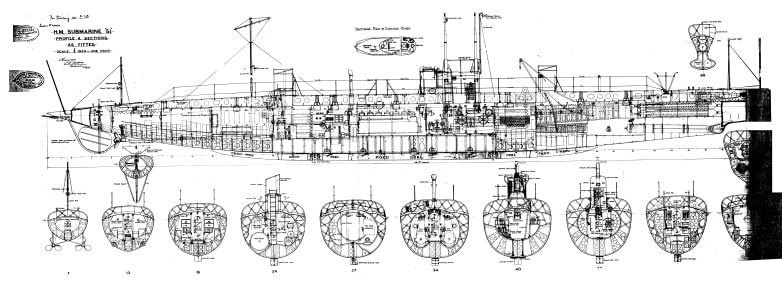
Launched in April 1916 she was commissioned as the Dolphin’s tender, and affected to the 4th flotilla, but her trials lasted for more month. laid up in January 1917 at Portsmouth she was renamed Swordfish in July and converted back as a patrol boat. She received a new forecastle, wheelhouse, plus a new taller funnel, two 12-pdr guns and depth charges. Batteries were replaced by ballasts. She was recommissioned in August 1917 and served as a tender for Victory, and was eventually accepted for service in January 1918, only to be broken up in 1922.
G class (1915), double-hullers built in emergency
These were fourteen submarines of 703t, of a new coastal type which design was triggered by a rumor that Germany was producing masses of double-hulled overseas boats. The panicked admiralty ordered a modified E type with a partial double hull, single forward TT tube and two beam. Seven G types were ordered on the 1914 estimates, while another serie of seven was ordered in November 1914. Tenders for five boats allowed to test new diesels, but MAN models being impossible to provide, they all were given Vickers models. Armament was changed during construction, with the 21 TTs relocated aft and 18in TTs were fitted to the bow. The boats were built by Vickers, Armstrong, Scott and White. Three subs were lost, one sunk by error (G9), another by enemy ship (G7) and another probably accidentally sunk (G8). All the others were unlisted and BU in 1920 to 1923.
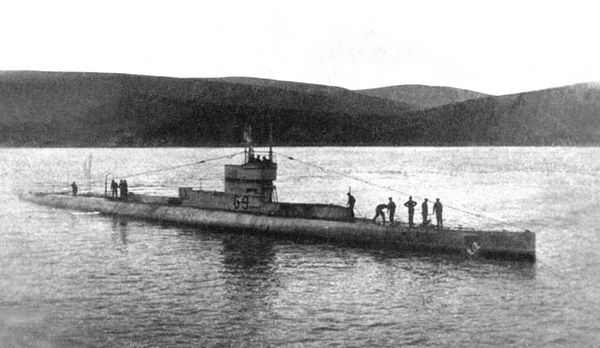
G9 at Scapa Flow
G class specifications |
|
| Dimensions | 46 x 4.9 x 3.2 m |
| Displacement | 363/525 t FL |
| Crew | 19 |
| Propulsion | 2 shafts, 2 diesels, 2 electric motors 900/400 hp |
| Speed | 14/8.75 knots |
| Range | 3000 nmi at 9.5 knots |
| Armament | 3 TT 457 mm (2 bow, 1 stern, 6 torpedoes), 1×2 pdr |
J class (1915), the Australians
Seven submarines, 1204t built at Devonport, Pembroke and Portsmouth Dyds. J3 and J4 were cancelled, the others were transferred to Australia (RAN). Rumors about German submarines fed yet another attempt to design a fleet submarine capable to operate with the Grand fleet. Vickers argued that to achieve the 20 knots required, three V12 diesels would need to be carried and the new design was prepared with haste and accepted with a projected figure of 19.5 knots top speed in mind in January 1915. The type J would remain the only triple shaft sub design to be approved. There was a partial double hull (56% of the length), but the three large free-flooding casings at the bow caused the sub to plow into the water and slow her down. As a result the plugs were later welded shut. At the end of the war they were all rearmed with a 4in (106 mm) gun in a raised bathtub forward of the conning tower, inaugurating a long tradition in British subs.
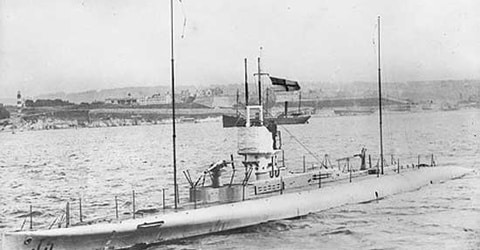
J-5
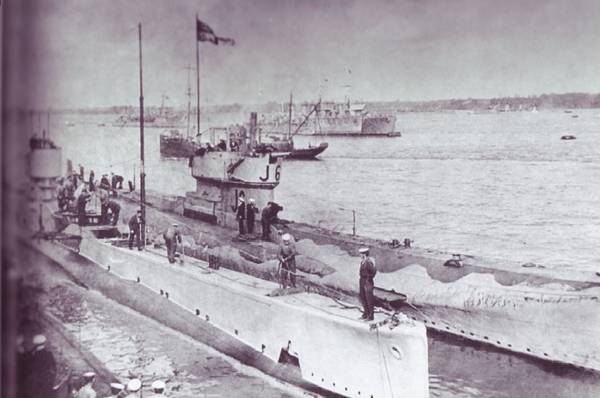
J-6, camouflaged
J class specifications |
|
| Dimensions | 84/83.7 x 7 x 4.3 m |
| Displacement | 1204/1820 t FL (1212/1280 J7) |
| Crew | 44 |
| Propulsion | 3 shafts, 3x 12 cyl. diesels, 2 electric motors 3600/1350 hp |
| Speed | 19.5/9.5 knots |
| Range | 5000 nmi at 12.5 knots |
| Armament | 6 TT 457 mm (4 bow, 2 beam, 12 torpedoes), 1x 12 pdr AA |
K class (1916-17), the turbine cruisers
These 18 submarines of 1980t were the result of a C-in-C competition in the spring of 1915 for a 24 knots submarine. Two designed were submitted, one from DNC and one from Vickers. The former was 300 tons lighter, one knot faster, carried larger TTs (21 instead of 18in) with a reduced power, 10,000 hp instead of 14,000 on the Vickers design. The latter proposed a radical solution, with eight of the new, untested V12 models that already were choosed to power the J class. Ultimately its design was not accepted, but obtained to develop the DNC design into a new larger oceanic fleet submarine. Orders followed in 1915 and 1916 but the last K18-21 were cancelled with the arrival of the new M class.
The K class was basically tailored for speed with Brown-Boveri steam geared turbines or Parsons ones for the K3, 4, 8,9,10 and 17), fed by two Yarrow boilers and 4 electrical motors, at the expense of range. There were tow small chimney on the superstructure behind the coning tower. The K type was well armed, with 4 bow and 4 stern TTs all of the standard “heavy” 21 in (533 mm) type, plus one twin revolving TT mount on the superstructure, 18 torpedoes in store, but also two 4in (102 mm) guns for and aft of the superstructure, and one QF 3 in gun (76 mm) for AA defence on a platform behind the conning tower.
All ships but three survived the war. K1 and K4 sunk by collision and K17 by an unknown cause. They had a reputation of bad luck and poor design, a result of an earlier faulty conception. These collisions were attributed to their close deployment with surface ships; The K17 was probably sunk because of an obstruction of the ventilator, left open. The disastrous “battle of may island” in 1918 which they took part in, was more of the result of poor navigation than bad design. These low ships speeding at night without lights in close vicinity of much faster destroyers and battlecruisers were a matter for having troubles.
An “improvised K” design was soon called to remedy the design issue of the serie, and 10 ships in total were ordered early in 1918 (six, later cancelled in November) and three more in December 1918 to be completed at Chatham which never happened. In fact only K26 was completed there in June 1923. She served for the whole interwar and was broken up in 1931.
Motors, batteries and rotating surface beam TTs were kept but two more tubes were added to the bow, which was also given more flare to improve seakeeping, and the superstructure was raised as well, encasing the fragile funnels and aeration systems while it was extended front of the conning tower to form a bathtub for the forward gun platform. The hydroplanes were moved 16ft further aft, less susceptible to damage and ballasts tanks were moved to the internal hull and below the waterline to improve diving.
K class specifications |
|
| Dimensions | 100.6 x 8.1 x 5.2 m |
| Displacement | 1980/2566 t FL |
| Crew | 59 |
| Propulsion | 2 shafts, 2 brow-Curtis/Parsons turbines, 2 electric motors 10500/1440 hp |
| Speed | 24/9.5 knots |
| Range | 3000 nmi at 13.5 knots |
| Armament | 10 TT 457 mm (4 bow, 4 beam, 1×2 revolving mount, 18 torpedoes), 2x 4in (102 mm), 1x 3in QF AA |
M class (1917-18): The battleship subs
Three 1594t submarines clearly apart all other designs: These were closely related to the K class and proceeded from the same idea, but the design was also brand new, with few in common. They would be forever famous as the “heavy gun” British subs, the only ones ever fitted with a 12 in (305 mm) battleship gun. It seems they had been ordered almost immediately when K18-21 were cancelled in February, may and August 1916 and laid down in July-September 1916. Originally one pair was built at Vickers and two at Armstrong Dyd however M4 was launched in July 1919 (cancelled) only to clear the slip.
The idea of the battleship gun was from submarine Commodore Hall, which argued a monitor submarine could be useful to complement torpedo attacks. Fifty shells had to be carried, in exchange from only eight torpedoes. Tests showed that once in surface the crew could fire within 20 secs or even from periscope depth at max elevation, about 30 secs when submerged with a round pre-loaded. The goal was to provide a submersible shore bombardment platform, and the idea was endorsed by Admiral Tudor. The guns chosen were the 40 cal Mk.IX part of the large stock available from deactivated Formidable group of pre-dreadnoughts. The whole idea was torpedoes were considered ineffective against moving warships at more than 1,000 yards (900 m). A gun was therefore a more viable option, with a hitting power well able to disable or destroy any “softskin” ship.
Main engines and motors were taken from the L class, meaning two Vickers V12 diesels for a top speed of 15 knots, and about 3500 nautical miles of range. Although the gun was capable to be trained 15° there was no real traverse. Elevation was 20°, depression 5°. But the paradox was in 1918 when they were put into service, the C-in-C had no role for them, and by default they would have been used as patrol submarines without their gun, which was vetoed by the first Lord of the admiralty. Eventually only M1 served actively with the 6th flotilla, and then 11th. She was rammed and sunk in 1924 off Start point by SS Vidar. Washington treaty’s limitation imposed the disarmament of these subs and M2 became a seaplane carrier, foundered off Portland in 1933. M3 became a minelayer and was paid off and BU in 1932.
M class specifications |
|
| Dimensions | 90.1 x 7.5 x 4.9 m |
| Displacement | 1594/1946 t FL |
| Crew | 65 |
| Propulsion | 2 shafts, 2 Vickers V12 diesels, 2 electric motors 2400/1600 hp |
| Speed | 15/9 knots |
| Range | 3840 nmi at 10 knots |
| Armament | 4 TT 457 mm (bow, 8 torpedoes), 1x 12in (305 mm) |
H class (1915-18), the “Americans”
With 20 and later 34 submarines of the improved H class has been ordered but actually only the first saw service. Back in November 1914, desperate of materials for shipbuilding, the admiralty contracted Bethlehem Steels to supply ten American H class submarines parts, which were assembled, because of US neutrality, in Canadian Vickers works at Montreal. A second batch was to be ordered at Bethlehem Steel proper for after the war, unarmed, also to be shipped to Vickers Canada. The first batch, delivered in MayèJune 1915 crossed the Atlantic, but the second were held up by the US Government until April 1917.
In between, Bethlehem steel managed to send the engines, motors and fittings for assembly of H21 in UK. Launching dates were kept secret. These single hulled ships gave good account of themselves, and after April 1917 six of the ten next boats (H11-H20) were given to Chile in compensation for the requisition of Almirante Latorre and her sister ship. The remainder were integrated to the Royal Canadian Navy. H3 sunk because of a mine, H5 by collision, and H6 ran aground on the coast and was captured. After the war she was turned to the Dutch Navy as O-8, having long years of service contrary to the British ones, sold in 1921.
The “Improved H” proceeded from an order in January 1917 for twelve boats of the same type as above, albeit larger and armed with 21 in Torpedo Tubes, all in the bow. In addition their engines and equipment were shipped from the USA. Eventually 34 boats would be ordered, in addition to Cammel Laird, Armstrong, Beardmore, Pembroke and Devonport. However with the war ending, only 22 were completed and put into service, the remainder being cancelled or the components used for twelve of the R class. Devonport boats were a mix with British engines and fittings, on US design. As usual with these single hull designs they had a small reserve of surface stability, and served all along the interwar and through WW2 for most, albeit as training subs.
H class specifications |
|
| Dimensions | 45.8 x 4.7 x 3.8 m |
| Displacement | 364/434 t FL |
| Crew | 22 |
| Propulsion | 2 shafts, 2 diesels, 2 electric motors 480/620 hp |
| Speed | 13/11 knots |
| Range | 1600 nmi at 10 knots |
| Armament | 4 TT 457 mm (bow, 6 torpedoes) |
R class (1918), the Sub-Killers
These were a special breed of submarines. In fact they had been the first “hunter-killers”, 30 years ahead of their time, specified by the admiralty as specialist of ASW warfare, and fast enough made to catch and torpedo U-boats. This March 1917 design was for a time buried, then resurrected by Commodore S in December with more TTs, and orders were placed to various Dyds, Chatham, Pembroke, Vickers, Armstrong and Cammell Laird. Built fast, they were launched in April to June 1918. These were lightweight boats designed with the old spindle shape of the first series, but using cross section from the H class to save time.

R class scheme
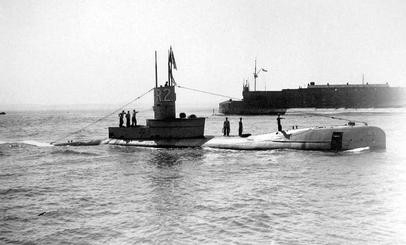
HMS R2
To make them fast enough they were give a single H type diesel (240 hp) but “j” class 220-cell battery for a total of 2400 hp, making these faster submerged at 15 knots, than surfaced at 9.5. They could also dive at 250 ft (75 m). They were armed with six bow TTs, with a reload for each. In addition the main shaft was mated to an auxiliary 25 hp motors for slow speed maneuvers, and a large rudder, but also for the first time a set of five hypersensitive microphones. However with the war ending, the class was not seriously tested and only H8 fired a torpedo on an U-boat but the faulty projectile failed to explode. Despite their advanced features, almost the “type XXI of their day” all the 12 boats built were written off and broken up in 1923.
R class specifications |
|
| Dimensions | 49.9 x 4.6 x 3.5 m |
| Displacement | 410/503 t FL |
| Crew | 22 |
| Propulsion | 2 shafts, 1 diesel, 1 electric motor 240/1200 hp |
| Speed | 9.5/15 knots |
| Range | 200 nmi at 8 knots |
| Armament | 6 TT 457 mm (bow, 12 torpedoes) |
L class (1917-18)
These 8+19+5 (32 total) 891t submarines were the last British subs to be planned for WW1. They proceeded for an order to replace the E class, and with provisions to stretch the boats for further improvements. The Admiralty wanted a well-proven saddle tank design, and the first two were in effect much modified E types. They were little variations in design from the L1-L2 (Vickers) to L8 all having a bathtub like gun platform at the forward end of the conning tower. These 8 boats were all BU in 1930.
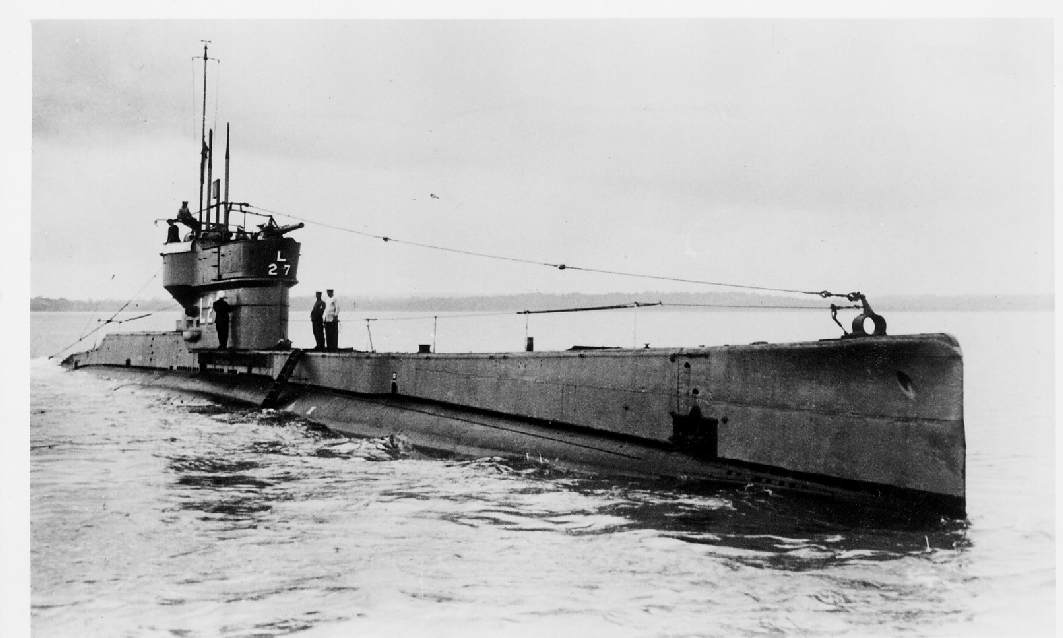
L27
The next “improved L” made a 19 boats serie (L9 to L49) but in reality many were cancelled in 1919. Their main difference was the adoption of 21 in (533 mm) bow TTs, while retaining their 18 in beam tubes. Some were modified as minelayers, having four bow TTs but carrying 14 to 16 mines. The latter were five boats ordered with mine-chutes much like the modified E class. Their pressure hull was lenghtened, with a watertight bulkhead abaft the bow TTs, and 78t more fuel was carried for extra range and their main gun was placed as to fire or of torpedo range whith the boat trimmed down.
Most actually served in the interwar, some BU in the 1930s, but three were still in service throughout ww2 as training boats. L10 was sunk by a German destroyer in 1918, and it was the only wartime loss (at least for ww1).
The last serie called L50 was to comprise a new serie ranging up to L74. However most were cancelled because of the armistice and only five boats were completed. Two unfinished boats were sold and completed as the Yugoslavian Hrabi class. They had a second platform for an additional 4in gun behind the conning tower. Also the beam TTs were deleted and the bow received 6 TTs. L55 actually served in the Baltic and sunk off Kronstadt by a patrol craft and was later raised and repaired, to be incorporated into the new Soviet Navy. Many features of this class would be adopyted in the next interwar serie, but this is reserved for the ww2 British submarine chapter.
L class specifications |
|
| Dimensions | 70.4/72.7 x 7.2 x 4 m |
| Displacement | 890/1074-1080 t FL |
| Crew | 35-38 |
| Propulsion | 2 shafts, diesels, 2 electric motors 2400/1600 hp |
| Speed | 17/10.5 knots |
| Range | 3800 nmi at 10 knots |
| Armament | 6 TT 457 mm (4 bow,2 beam, 10 torpedoes), 1x 4in (102 mm) |
Links & sources
Submarines of the RN
K-class subs (wikipedia)
E-lass subs (wikipedia)
On harwichanddovercourt.co.uk
The K class on Mil Factory.com
On dropbears.com
Article on henry Stoker, AE2 sub Dardanelles
Timeline of submarines
Specs Conway’s all the world fighting ships 1860-1905 and 1906-1922.

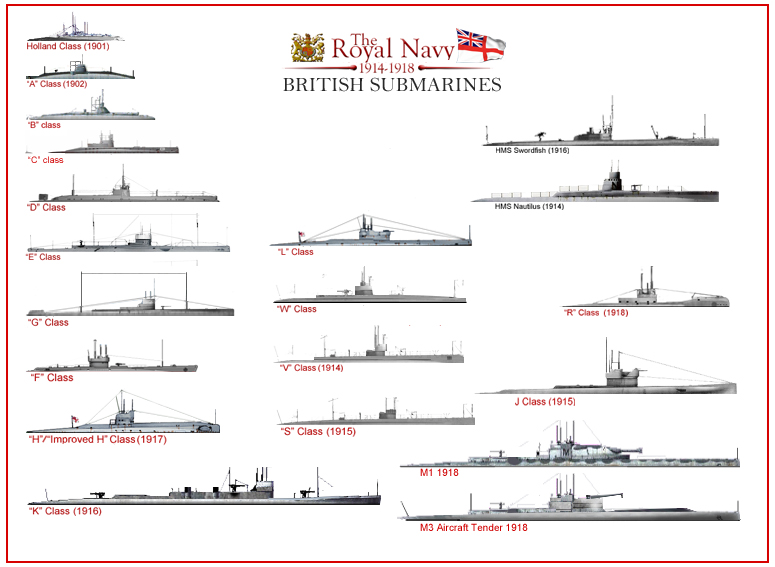
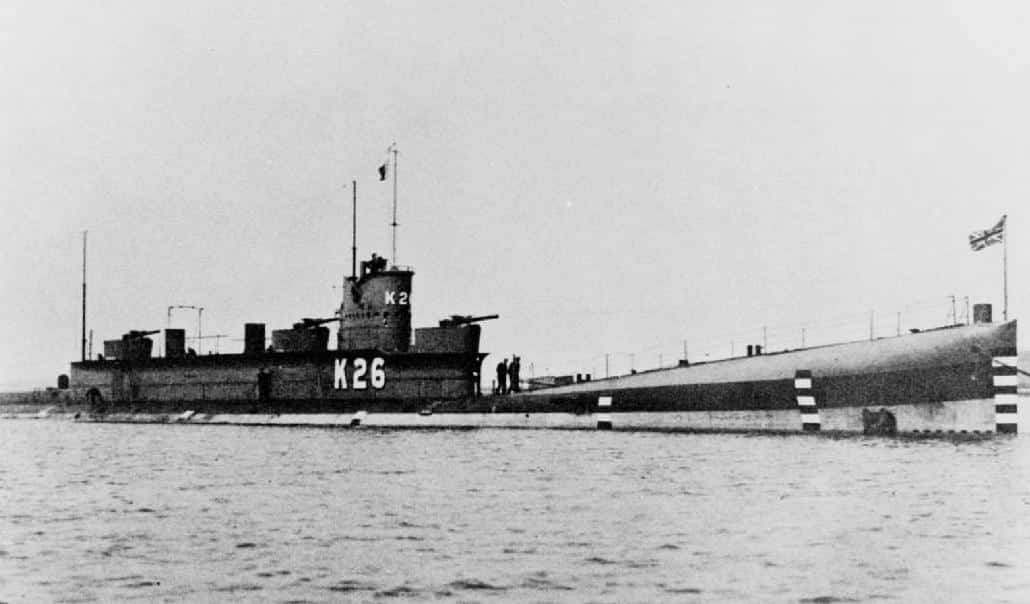
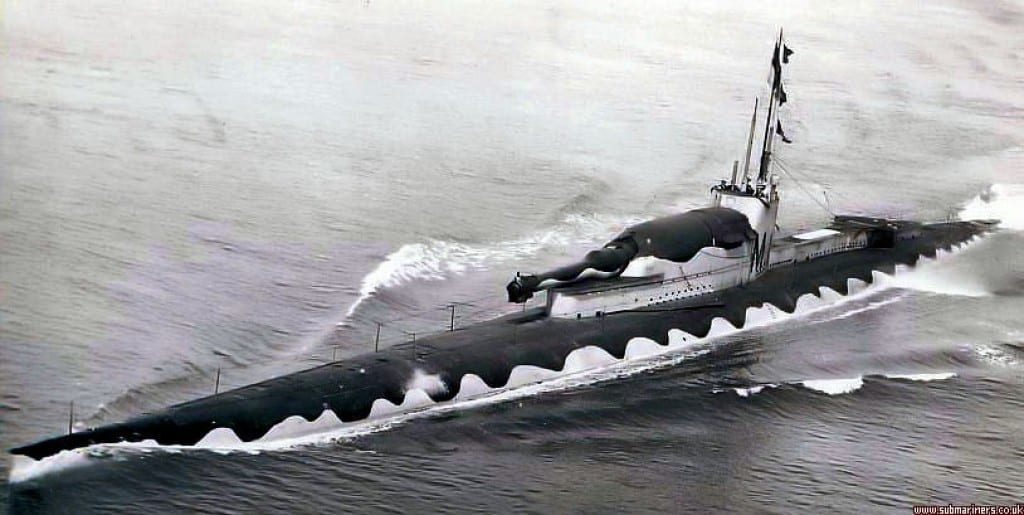


 Latest Facebook Entry -
Latest Facebook Entry -  X(Tweeter) Naval Encyclopedia's deck archive
X(Tweeter) Naval Encyclopedia's deck archive Instagram (@navalencyc)
Instagram (@navalencyc)





 French Navy
French Navy Royal Navy
Royal Navy Russian Navy
Russian Navy Armada Espanola
Armada Espanola Austrian Navy
Austrian Navy K.u.K. Kriegsmarine
K.u.K. Kriegsmarine Dansk Marine
Dansk Marine Nautiko Hellenon
Nautiko Hellenon Koninklije Marine 1870
Koninklije Marine 1870 Marinha do Brasil
Marinha do Brasil Osmanlı Donanması
Osmanlı Donanması Marina Do Peru
Marina Do Peru Marinha do Portugal
Marinha do Portugal Regia Marina 1870
Regia Marina 1870 Nihhon Kaigun 1870
Nihhon Kaigun 1870 Preußische Marine 1870
Preußische Marine 1870 Russkiy Flot 1870
Russkiy Flot 1870 Svenska marinen
Svenska marinen Søværnet
Søværnet Union Navy
Union Navy Confederate Navy
Confederate Navy Armada de Argentina
Armada de Argentina Imperial Chinese Navy
Imperial Chinese Navy Marinha do Portugal
Marinha do Portugal Mexico
Mexico Kaiserliche Marine
Kaiserliche Marine 1898 US Navy
1898 US Navy Sovietskiy Flot
Sovietskiy Flot Royal Canadian Navy
Royal Canadian Navy Royal Australian Navy
Royal Australian Navy RNZN Fleet
RNZN Fleet Chinese Navy 1937
Chinese Navy 1937 Kriegsmarine
Kriegsmarine Chilean Navy
Chilean Navy Danish Navy
Danish Navy Finnish Navy
Finnish Navy Hellenic Navy
Hellenic Navy Polish Navy
Polish Navy Romanian Navy
Romanian Navy Turkish Navy
Turkish Navy Royal Yugoslav Navy
Royal Yugoslav Navy Royal Thai Navy
Royal Thai Navy Minor Navies
Minor Navies Albania
Albania Austria
Austria Belgium
Belgium Columbia
Columbia Costa Rica
Costa Rica Cuba
Cuba Czechoslovakia
Czechoslovakia Dominican Republic
Dominican Republic Haiti
Haiti Hungary
Hungary Honduras
Honduras Estonia
Estonia Iceland
Iceland Eire
Eire Equador
Equador Iran
Iran Iraq
Iraq Latvia
Latvia Liberia
Liberia Lithuania
Lithuania Mandchukuo
Mandchukuo Morocco
Morocco Nicaragua
Nicaragua Persia
Persia San Salvador
San Salvador Sarawak
Sarawak Uruguay
Uruguay Venezuela
Venezuela Zanzibar
Zanzibar Warsaw Pact Navies
Warsaw Pact Navies Bulgaria
Bulgaria Hungary
Hungary

 Bundesmarine
Bundesmarine Dutch Navy
Dutch Navy Hellenic Navy
Hellenic Navy Marina Militare
Marina Militare Yugoslav Navy
Yugoslav Navy Chinese Navy
Chinese Navy Indian Navy
Indian Navy Indonesian Navy
Indonesian Navy JMSDF
JMSDF North Korean Navy
North Korean Navy Pakistani Navy
Pakistani Navy Philippines Navy
Philippines Navy ROKN
ROKN Rep. of Singapore Navy
Rep. of Singapore Navy Taiwanese Navy
Taiwanese Navy IDF Navy
IDF Navy Saudi Navy
Saudi Navy Royal New Zealand Navy
Royal New Zealand Navy Egyptian Navy
Egyptian Navy South African Navy
South African Navy






























 Ukrainian Navy
Ukrainian Navy dbodesign
dbodesign